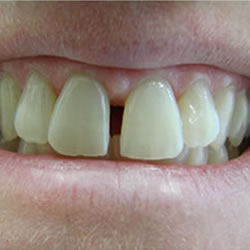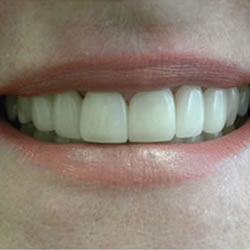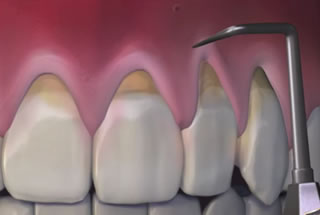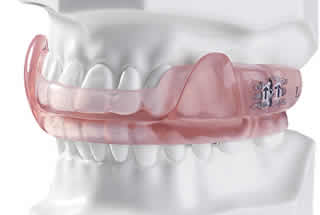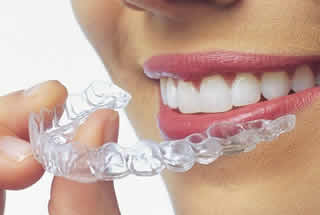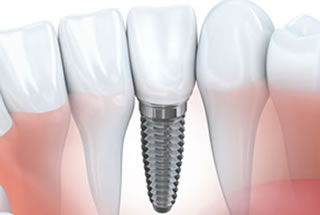
Simple pleasures like enjoying a cup of coffee or sipping red wine can stain your teeth and leave you with a yellowed smile. Instead of giving up some of your favorite pastimes, you can restore your smile with professional teeth whitening. Home whitening options are available, but to achieve the fastest and most dramatic improvements, professional whitening methods are the way to go.
Teeth whitening is a quick and safe procedure, making it the most popular cosmetic dental procedure today. Some patients even have it done during their lunch break and go right back to work. It’s that easy! The process typically involves protecting your gums from becoming sensitive during treatment, and then applying a whitening solution to your teeth. The solution stays in place for a specific length of time and often a special ultraviolet light is shined on them to enhance the whitening process. Then your teeth are rinsed. The process might be repeated in some areas with severe stains, but the dental professional is careful not to over-whiten your teeth or cause discomfort.
You can choose the shade of white that you would like your teeth to be, and your dentist will help you make the best choice. The goal should be to look natural and complement your skin tone. Since teeth whitening is a safe process, just about everyone is a candidate unless you have severely poor oral health. It is usually painless, although those with extremely sensitive teeth may have some discomfort that should dissipate shortly after treatment.
Rejuvenating your smile with teeth whitening is a simple way to make you look younger and enhance your smile. It also improves your self-esteem by giving you confidence in your appearance. A bright, white smile can be yours today through professional teeth whitening.
Our dental office is located in Toronto

A pretty smile has an immediate impact on those you meet. Without saying a word, it conveys that you take care of yourself and exudes a higher confidence level. A yellowed, dull, stained smile can send the opposite message. It can get in the way of presenting yourself in the best possible way.
Even when you practice good dental hygiene, your teeth are at risk of discoloration. Age, drinking and eating certain foods, and smoking each can negatively affect the shade of your teeth. You may be able to slow down the damage by avoiding such habits, but it’s nearly impossible to maintain the bright white smile of your youth. That’s when teeth whitening comes to the rescue.
There are a number of teeth whitening methods available today. Some of them involve buying over-the-counter products at your local drugstore for use at home, and others require a trip to see a professional. Choosing the most effective method for your teeth depends on the degree of discoloration or staining that you have, as well as your smile goals. The various methods have different levels of impact on the shade of your teeth.
Products for home use are inexpensive, readily available, and simple to use. Some popular options include whitening toothpastes, gels, and strips. Make sure you follow the directions carefully, and be patient because visible results can take some time of consistent use.
For quicker and more dramatic impacts to your smile, professional whitening is the way to go. Commercial methods employ more powerful ingredients than those available for home use. Also, special tools are often used such as ultraviolet lights to enhance the procedure. Professional whitening methods are able to improve much more severe stains and discolorations than home products. Whitening performed by a dental professional also usually lasts longer than what you might achieve at home.
The bottom line about teeth whitening is that it can be a fast and effective way to improve your look. Don’t go through life hiding your smile, but brighten your appearance with teeth whitening.
If you live in the Toronto area contact us today

You’re not the only one if you feel like your smile has become dull and yellowed. This happens to nearly everyone, and it is the most common complaint that people have about the look of their smiles. There is no reason to live with a discolored smile. Teeth whitening is available to restore your pearly whites.
There are a number of reasons that your smile has changed over the years. Aging causes tooth enamel to thin and allow the yellow-tinged dentin layer to show through. Dark-colored foods and drinks stain teeth, some medications produce the side effect of darkening teeth, and tobacco use creates difficult stains. Teeth may also change color due to mouth trauma.
Whatever the culprit is for your diminished smile, teeth whitening is a simple way to restore it. Whitening products contain bleaching agents that break up stains so that the color is less concentrated and your teeth look brighter. However, teeth whitening does not work in all situations. It does not affect restorations like veneers, fillings or crowns. Whitening is also not usually effective on stains resulting from injury or medications. Yellow teeth are the most likely to respond to teeth whitening, while brown or gray tones might be less improved.
There are numerous options for teeth whitening. Home products are available at your local drugstore like whitening toothpastes, gels, pens, strips and more. These methods focus on removing surface stains from your teeth. At-home bleaching kits are another option, typically obtained from your dentist, that involve filling a mouth tray with a special bleaching solution and wearing the trays for a time period like overnight. These kits are stronger than over-the-counter methods, but not as strong as professional whitening performed in a dental office. It is accomplished in about an hour in the dental chair using a concentrated bleaching agent and special lighting or laser to enhance the process, and provides the most dramatic results.
Consult your dentist for advice on the best whitening methods to use on your teeth. Every patient is different and certain methods may be more effective or comfortable for various people.
We look forward to seeing you in our Toronto dental office

More and more people today are heading to their dentist’s office to brighten their smiles through teeth whitening treatments. Although you can try to maintain white teeth by limiting foods and drinks that stain or stopping habits like smoking, the truth is that teeth are prone to discoloring over time. If you’re considering undergoing teeth whitening, get the facts before you go.
Is teeth whitening safe?:
Most people are able to have their teeth whitened successfully without any issues. However, not everyone has good enough oral health to safely undergo treatment. Healthy teeth and gums are necessary so that the procedure is comfortable and effective. Patients with extensive fillings or crowns may not be the best candidates. Teeth that have extremely dark stains or discolorations from certain things like medications may not attain desired results.
How do I know if I’m a good candidate?:
A complete oral examination by your licensed dentist is the best way to determine if teeth whitening is right for you. During the assessment, your dentist will look for decay, receding gum lines, fillings, enamel condition, tooth sensitivity and more to decide if treatment is advised. Sometimes dental work can be done to restore oral health and then whitening becomes an option.
What is the process?:
Most professional teeth whitening treatments performed in a dental office are done with a high concentration peroxide bleaching agent and enhanced with special lighting to activate the gel. The dentist usually coats your gums with a product to limit sensitivity, and then the bleaching gel is carefully placed onto your teeth. Light is directed to the area, typically in three 15-minutes sessions. The dentist monitors the entire process for your safety and comfort.
What results can I expect?:
It is important to discuss your specific case with your dentist prior to treatment so that you have realistic whitening goals in mind. The degree of whitening often depends on the level and cause of your tooth discoloration. Some patients achieve a couple of shades brighter, while others whiten up to ten shades.
We look forward to seeing you in our Toronto dental office

It’s a fact of life that teeth can become dingy and yellowed through the years. Your diet, age, personal habits and more affect the shade of your teeth. Even with the best care, it’s nearly inevitable that at some point you’ll want to brighten your smile. Once you pursue teeth whitening, you’ll want to be sure to make your new smile last as long as possible.
Over-the-counter products are readily available from your local drugstore and simple to use. However, they can take a long time to obtain full results and even then, you may not achieve the desired shade you’d like. Professional teeth whitening is the fastest and most dramatic way to brighten your smile.
If you spend the time and money to whiten your teeth professionally, making it last will be important to you. Results can last for a long time, but probably not forever. Here are some tips for making your white teeth last longer:
- Watch your diet especially carefully for the first 48 hours following treatment. Your teeth are at the most risk for staining during this timeframe.
- For the first few days, avoid eating known staining foods like blueberries, beets, dark soups, marinades, sauces, curry or tomato products.
- At first, avoid broccoli, green beans, peas, sprouts, corn, or skinned potatoes. These have increased risk of particles getting stuck into the highly susceptible tooth pores after whitening treatment.
- Watch out for citrus fruits that are high in acidity, which can also make your saliva more acidic. Your teeth are more prone to damage from acid when they already have increased sensitivity from the whitening chemicals.
- Avoid drinking dark colas or coffee, since both can stain your teeth no matter when you drink them.
- Get in the habit of drinking from a straw so that dark colored drinks don’t come into as much contact with your teeth.
Choosing the right foods and drinks after teeth whitening can make a big difference in the length of time your teeth stay white. Make the best decisions to enjoy your bright smile.
If you need a dentist in Toronto contact us today
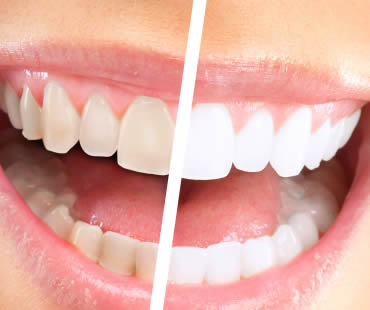
Nobody is happy with yellow or brown teeth. Ugly stains from smoking or consuming foods and drinks prone to discoloring your teeth can make you a good candidate for teeth whitening. There are many techniques available to restore your bright smile. The main two categories of teeth whitening are either at-home kits or professional treatment in a dental office. Let’s learn about these to see which you’d like to use to brighten your smile.
At-home teeth whitening
There are a variety of products you can try yourself to whiten your teeth. These treatments usually take a few weeks of use before your teeth are noticeably whiter. Also remember that most of these products cannot achieve as high of a level of whiteness as those performed professionally.
- Kits – whitening kits contain a tooth mold and gel to place inside the mold. You wear the filled mold for about 30 minutes for 2-3 weeks.
- Strips – thin whitening strips are coated with peroxide gel, and then you apply the strips directly to your teeth for 30 minutes for 14 days. Results become evident in a few days and last about four months.
- Toothpaste – brushing with whitening toothpaste must be done consistently and you must be patient because reaching the desired outcome usually takes a couple of months.
Professional teeth whitening
Treatments done by a dentist are the fastest and most effective way to regain your pearly whites.
- Laser whitening – the dentist coats your teeth with a hydrogen peroxide solution and then shines a laser light on them. This oxidizes the stains and gives them a whiter appearance.
- Porcelain veneers – if your teeth are severely stained and other whitening techniques haven’t done the trick, your dentist may recommend porcelain veneers. These shells permanently cover your teeth and provide a beautiful smile.
Teeth Whitening dentist in Toronto







 E-Mail Us
E-Mail Us  416-595-5490
416-595-5490